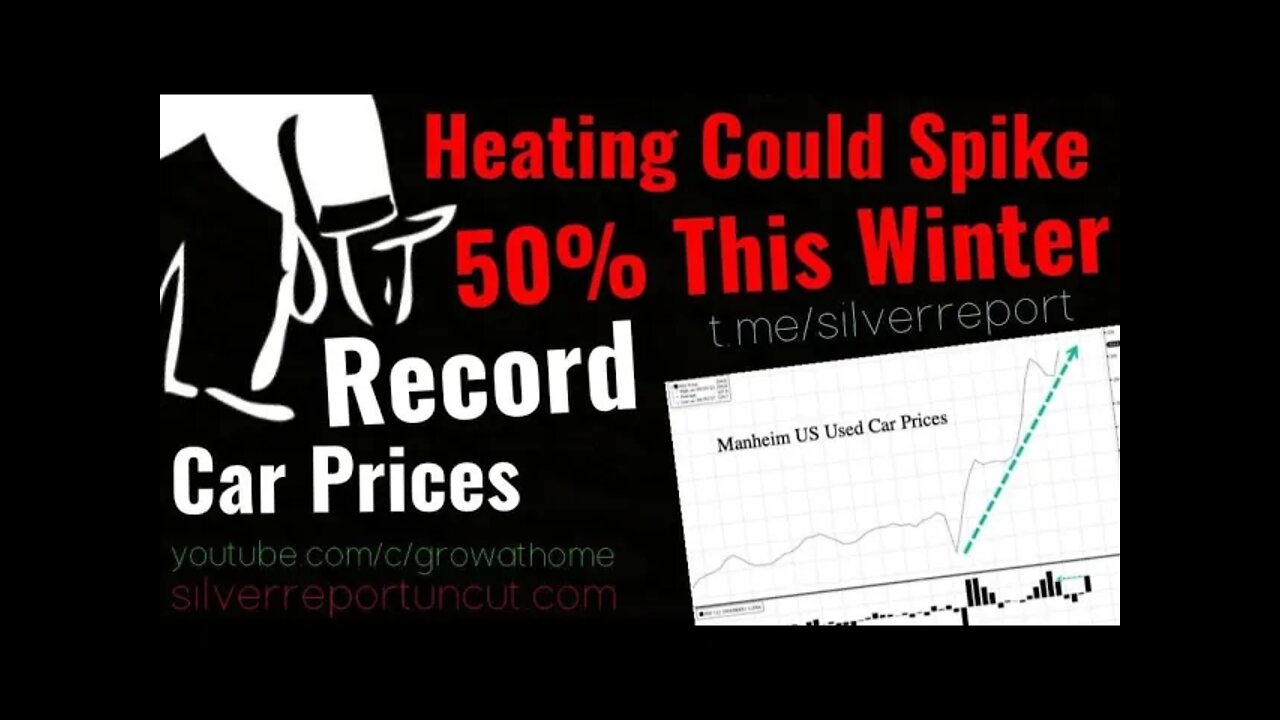Premium Only Content

Heating Costs Could Spike 50% This Winter, Car Prices Hit New Record As Vehicle Sales Melt Down
Subscribe to grow at home http://youtube.com/c/growathome
follow our backup channel
http://bit.ly/odyseesru
http://silverreportuncut.com
Subscribe to the SRU podcast
http://soundcloud.com/silverreport
http://silverreportuncut.podbean.com
Follow Us On Telegram http://t.me/silverreport & https://parler.com/profile/silverreport/posts
anyone can post on our public group http://t.me/silverreportforum
Ad revenue is down almost 70%, it's viewers like you who help keep the sru coming! you can donate via crypto at our website or consider supporting our work on
http://buymeacoffee.com/silverreport
https://www.patreon.com/silverreport
New car prices hit a new all-time high in September due primarily to snarled supply chains, according to Kelley Blue Book.
At $45k, the average transaction price for a new car was up 12.1% (or $4,872) from one year ago in September and monthly up 3.7% (or $1,613) from August. Here are car prices for individual carmakers.
"The record-high prices in September are mostly a result of the mix of vehicles sold," said Kayla Reynolds, an analyst for Cox Automotive.
"Midsize SUV sales jumped in September compared to August, and full-size pickup share moved up as well. Sales of lower-priced compact and midsize cars, which had been commanding more share during the summer, faded in September," Reynolds said.
All-time-high prices come as the entire industry endures a slowdown in sales. Total sales last month were approximately a million cars, a 7.3% monthly decrease, and one of the lowest volumes in the past decade.
Dwindling sales are likely a function of two things, a worldwide shortage of microchips that have shuttered many automobile factors and possibly higher prices are creating demand destruction among buyers.
Over the last year, dealership inventories have been tight due to supply chain difficulties and forced dealers to reduce incentives and discounts to prospective car buyers. Incentives were only 5.2% of the average transaction price last month, compared with 10% a year ago.
propane costs are forecasted to rise by 54%, heating oil costs to rise by 43%, natural gas costs to rise by 30%, and electricity costs to rise by 6 percent. And with natural gas consumption projected to rise by 3% this winter, households are expected to spend $746 this winter, up from $573 last winter.
The increase in natural gas heating costs varies by region with the Midwest U.S. leading the price hike at a 45% increase from last winter, and the Northeast expecting a hike of 14%.
Nearly half of all U.S. households use natural gas as the primary source of heating. Households relying on heating oil over winter will spend $1,734 over winter, relative to $1,212 last winter.
Houses in Northeastern regions will be more affected by the price hike as nearly one in five homes in the region rely on heating oil as their primary source of space heating. The projection is based on the Brent crude oil price, which helps determine the prices of U.S. petroleum products.
“The higher forecast Brent crude oil price this winter primarily reflects a decline in global oil inventories compared with last winter as a result of global oil demand that has risen amid restrained production levels from OPEC+ countries,” according to the EIA.
-
 16:33
16:33
SRU
2 years ago $0.06 earnedMy 5 Youtube Channels Stolen By Elon Worshipping Hacker Who Absorbed My Online Identity
6656 -
 4:22:25
4:22:25
sophiesnazz
5 hours agoLETS TALK ABOUT BO7 !socials !specs
3.18K -
 1:27:30
1:27:30
Redacted News
4 hours ago"There will be consequences!!!" Trump issues big threat to Putin ahead of peace summit | Redacted
86.8K147 -
 LIVE
LIVE
Amish Zaku
2 hours agoWar Thunder - Tank Tuesday
97 watching -
 1:27:05
1:27:05
Kim Iversen
4 hours agoIsrael DEMANDS X Remove Posts and X COMPLIES | Socialist Groceries Coming To A Store Near You!
40.9K97 -
 1:11:53
1:11:53
vivafrei
11 hours agoThe Great Replacement of American Truckers With Unskilled Foreign Labor - Live with Gord Magill
93.5K65 -
 1:05:13
1:05:13
Sarah Westall
4 hours agoEU Falling, United States Barely Hanging on - Strength and Courage Needed to Fight for Free Speech
39.1K5 -
 LIVE
LIVE
LFA TV
13 hours agoLFA TV ALL DAY STREAM - TUESDAY 8/19/25
813 watching -
 2:11:18
2:11:18
The Quartering
6 hours agoToday's Breaking News! Disgusting Grocery Shopping "Haul" Goes Viral, Las Vegas Collapse & More
112K34 -
 5:43:27
5:43:27
StoneMountain64
7 hours agoBest Extraction shooter is FINALLY on Console (+CoD Reveal Today)
59.8K